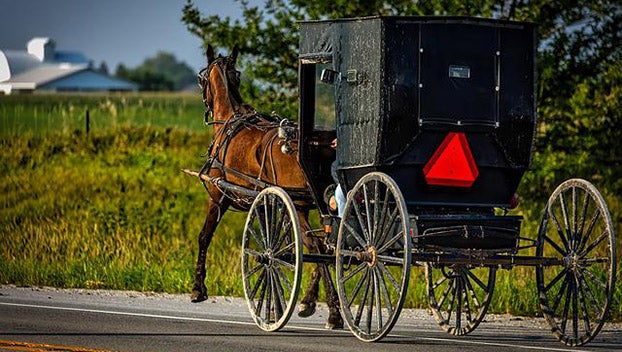How will Amish buggy law be enforced? Counties weigh options
Published 5:24 am Friday, May 3, 2024
|
Getting your Trinity Audio player ready...
|
If you have an animal-drawn vehicle on the road, like an Amish buggy for example, a change in Virginia law now requires lights or reflectors to be displayed. It’s something that was brought up in the wake of the recent accident in Buckingham County involving an Amish family. But the problem is that some communities are still learning about the new law’s existence and some law enforcement agencies don’t see how it’ll help prevent accidents.
“The animal drawn vehicles that we have seen already have lights, slow moving signs, slow moving flashing signs,” said Prince Edward County Sheriff Tony Epps.
After reading comments on buggy safety in a recent Herald story, retired Sen. Frank Ruff Jr. contacted an area county official to let him know of the passage of Senate Bill 938, which added wording that made lights and/or reflectors a requirement for all such vehicles, including buggies.
“All vehicles, including animal-drawn vehicles, or other mobile equipment not otherwise in this article required to be equipped with specified lights shall carry at least one or more white lights to the front and a red light to the rear visible in clear weather from a distance of not less than 500 feet to the front and rear of such vehicles,” SB 938 states. “Such lights may be battery-operated.”
The bill, which sailed through both chambers of legislature without a single vote in opposition, also allows animal-drawn vehicles to use a reflector of a type, size and color approved by the Virginia State Police superintendent to be permanently affixed to the rear and front of such vehicles in lieu of or in addition to the lights.
No discussions over Amish buggy law
“I have no idea why the issue has not been raised in counties that are home to Amish communities,” Ruff said in a Friday interview. Several county officials, however, indicated they did not know about the 2023 bill or its passage.
Ruff said the legislation came about because of the loss of life in a 2022 crash that killed a Cumberland County Amish couple and injured their eight children.
“That however was not the first, only the most gruesome,” Ruff said. “This issue has become much more of a problem in recent years. We now have more Amish living in our region than in years past.”
The retired state senator said this combined with the factor that during the COVID-19 pandemic keeping statistics of stops by race, there have been fewer officers writing citations for driving over the speed limit.
“Having reflectors or battery operated flashing lights give more time for drivers to react,” Ruff said. “While other lights might be better, these alternatives give families a safety option without creating a conflict with their religious beliefs.”
He said most Amish communities understand that their family’s safety should be a higher priority. While a few leaders do not, he said he sides with safety.
“That is why I introduced the bill. Legislators agreed with me that safety was the higher priority,” Ruff said. “I pointed out that most of the buggies and wagons were on country roads that often had blind spots and curves. This created a situation where a driver could be driving at the speed limit and next thing they know is a horse drawn vehicle directly in front of them.”
A need to respond
Alert drivers, on clear days, can respond but particularly at dusk or dawn there is less chance of seeing the wagon and reacting quickly enough, he went on to say.
The senator said his bill, signed into law by Gov. Glen Youngkin on March 23, 2023, shouldn’t be used to write tickets for failure to comply.
“I hope that law enforcement does not give citations to families; but I hope that, when seen, they encourage owners to do the responsible thing,” Ruff said.
Both Charlotte County Administrator Dan Witt and Buckingham County Director and Chief of Emergency Services Cody Davis indicated that they did not know about passage of Ruff’s legislation.
“This is new information, thus plans to take any action are not yet formulated,” Davis said Monday. “County officials will need to convene and draft a plan of action for our board of supervisors to review.”
When asked about the type of lights and reflectors that are approved for use, he said officials do not yet have that information.
“We are asking the same questions and would look to our partners in law enforcement for their opinions,” Davis said.
Witt indicated the need for flashing lights in an interview for last week’s article. He noted that there are times of the day and night when it is difficult to see an Amish buggy on the highway.
If a buggy is traveling on a highway with a higher speed limit, Witt said a car traveling at 55-60 mph can come up on it “very quickly.”
Questions raised about Amish buggy law
The code section requirement in the Ruff bill is for white lights in the front and a red light in the back,” Virginia State Police Public Relations Director Corrine Geller said Monday.
“A majority of the Amish communities in Buckingham and Cumberland counties have also added amber lights to the rear of their buggies,” Geller noted. “Reflective tape of any color is also encouraged and permitted.”
She explained that the ultimate goal is to make a dark-colored buggy as visible as possible, especially in the dark.
As the Amish population has grown within the region over the past several years, Geller said the agency along with sheriff’s offices, police departments and Virginia Department of Transportation have established work groups to engage with the different Amish communities’ leadership.
“This has enabled us to not only learn from them of their needs and concerns, but to also help engage with the communities on how best to enhance their safety while traveling on local roads and highways,” Geller said.
These working groups also led VDOT to post signage throughout several area counties advising motorists to be on alert for horse-drawn buggies, she said.
“Just like we do for motorcycle and bicycle safety, state police troopers have incorporated horse-drawn buggies to presentations before area students, new drivers, civic groups, etc. on how to safely share the road with all vehicles,” Geller said. “State police does press advisories and interviews with regional media, as well as safety postings on social media, to help raise awareness among drivers of the commonplace of horse-drawn buggies in certain communities.”
She pointed out that many residents are already accustomed to encountering slow-moving farm vehicles on secondary and rural roads.
“We encourage them to remain just as vigilant for horse-drawn buggies when coming through curves or cresting hills,” she said.
State code section 46.2-1016 makes the failure to have the proper lights or reflectors on an Amish buggy a traffic violation. Geller noted that a violation is a citation.
“State police troopers have the authority to warn, summons or arrest in regards to violations of the Code of Virginia,” she said.”However, we also recognize the value of working with the Amish to make sure they have an understanding of what the law requires and assisting them any way we can with making sure their vehicles are in compliance, as required.”
Driver awareness is key
Virginia Department of Motor Vehicles Public Relations and Media Liaison Jillian Cowherd said drivers need to slow down and be courteous to others on the road, noting it goes “a long way toward keeping each other safe.”
“First and foremost it is important for drivers to remember that we share our roads with many types of vulnerable road users and slow moving vehicles, like horse-drawn buggies,” Cowherd said. “As horse-drawn buggies move more slowly than vehicles, it is important to provide them with ample room and not honk as it could startle the horses.”
According to the Virginia Driver’s Manual, she said that when it is safe to pass an Amish buggy, a motorist must allow at least three feet of space.
“Drivers should always follow posted speed limits and never drive distracted to ensure they have enough time to react safely when they encounter a slow moving vehicle,” she said.
The DMV driver’s manual can be found online at dmv.virginia.gov/sites/default/files/forms/dmv39c.pdf.






